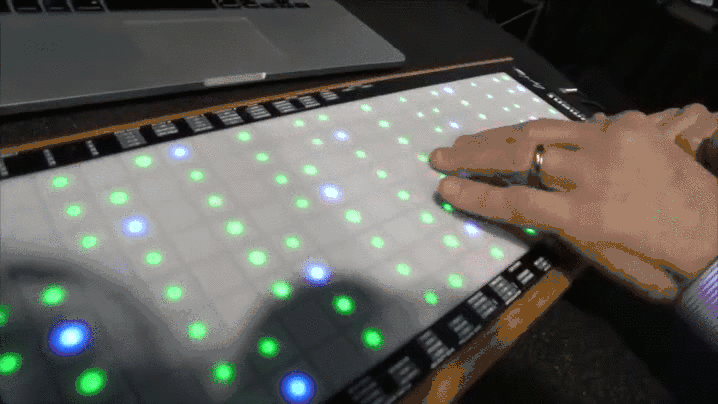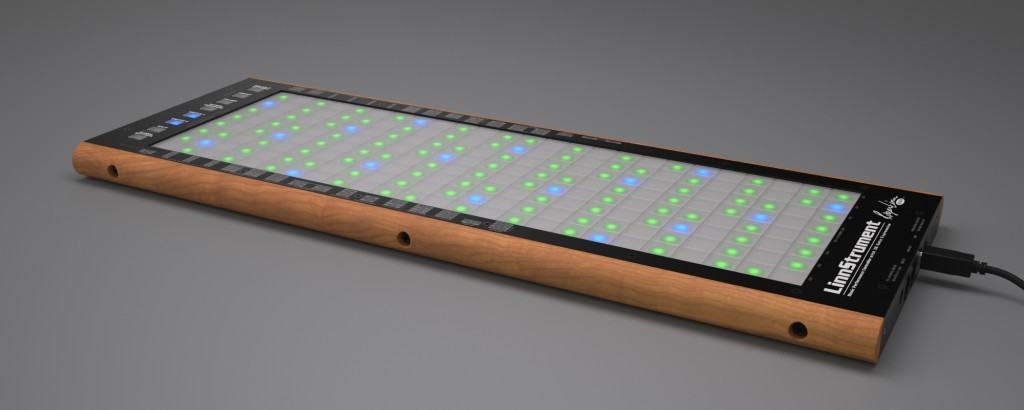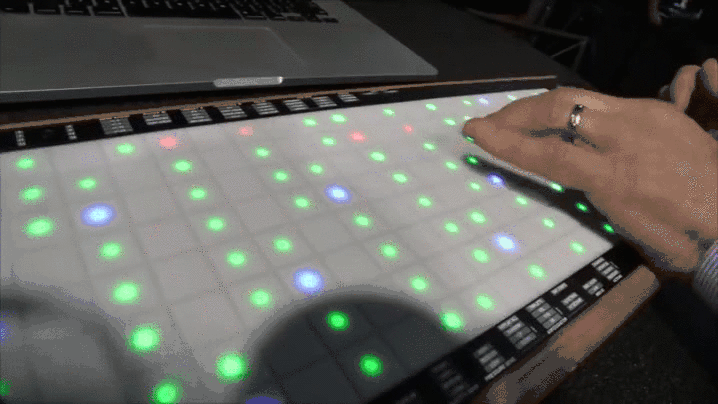Musical innovation is one of my favourite types of innovation. Re-imagining how an instrument can be played as suppose to how it could sound is rare. Things like this often come across as gimmicky at first, but sometimes end up changing music forever. Take a look at this new controller and imagine how it would change your music. It truly is impressive.
Why does the music in Blade Runner resonate so deeply? The thing that made this 70s-era synthesizer so special was an inspired feature called Polyphonic Pressure.
The CS-80 was one of the last keyboards where a notes volume could be tweaked by varying the finger pressure on a key. The resulting acoustic-like voicing was eerie and remarkably expressive.
The thing that made this ’70s-era synthesizer so special was an inspired feature called “Polyphonic Pressure.” The CS-80 was one of the last keyboards where a note’s volume could be tweaked by varying the finger pressure on a key. The resulting acoustic-like voicing was eerie and remarkably expressive.
By massaging individual keys to varying degrees, Vangelis could summon the plaintive cries of tin foil unicorns or replicants in love. Alienation and melancholy never sounded so good.
Like Roy and Pris, though, the CS-80 was doomed. In 1980, when killjoy accountants cited high production costs and shrinking profit margins, management pulled the plug. Just like that, Polyphonic Pressure vanished from the Yamaha lineup.
For musicians who mourned the passing of this iconic analog synth, there’s reason to rejoice. After 35 years, the next-gen polyphonic pressure instruments have arrived. On the electronic music circuit they’re known as PMCs: polyphonic multi-dimensional controllers. It’s the “multi” bit that’s important.
Unlike Vangelis’ beloved CS-80, which could sense movement in one dimension, these sophisticated MIDI machines can sense finger movement in three dimensions simultaneously—in addition to controlling volume, a musician can also change a note’s pitch and timbre in real time.
It’s revolutionary, and the manifesto goes something like this: The MIDI keyboard, that ubiquitous human interface popularized by Brit synth bands during the Reagan administration, is dino-tech.
Thanks to progress in smart materials, sensors, software, and computing power, an improved 3-D pressure-sensitive interface has emerged to take its place.
These instruments have liberated musicians, enabling them to play complex and hauntingly beautiful music the likes of which has never been heard before.
Synthtopia, a website that celebrates digital music and analyzes every PMC prototype in fanatic detail, has culled the contestants in this race to a handful of contenders. There’s the Roli Seaboard, a surrealist piano with a squishy keyboard that feels like human flesh. The Haken Continuum, a crimson strip that looks like the world’s longest mouse pad, has its share of supporters, including Led Zeppelin bassist and keyboardist John Paul Jones.
Another entry is the Madrona Soundplane, a scored slab of walnut that could be mistaken for a pinochle board. The dark horse is the Eigenharp, a one-man-band contraption for postmodern Highlanders; in addition to 132 keys and two strip controllers, there’s also a breath pipe used to trigger notes or apply effects and filters.
If Vegas were laying odds on the PMC sweepstakes, though, the smart money would be on the LinnStrument. To begin with, the price is right. At $1,500, it’s the most affordable of the fancy, made-to-order PMCs (The Seaboard Grand is almost $9,000. The Eigenharp Alpha and Continuum aren’t cheap either: $7,328 and $5,290.) The LinnStrument also is easy to play and relatively compact, small enough to toss in a backpack.
The big selling point, though, is the guy who designed it: Roger Linn. In the music biz, he’s a bankable brand with a proven record of creating wildly successful instruments.
From Prince and Stevie Wonder to Dr. Dre and Puff Daddy, Linn’s basement inventions defined pop music for two successive decades. The LM-1, the world’s first programmable sampled-sound drum computer, was the beat box of the ’80s.
Consider Michael Jackson’s Thriller, the best-selling pop album of all time. Every drum on that record, from the kicks to the snares, came from the chunky LM-1 circuit boards.
The self-taught engineer followed that success with the Akai MPC60, the classic 16-pad controller that made sampling beats child’s play, and launched hip-hop from the projects to MTV. Miraculously, the winning streak has continued.
With the AdrenaLinn III (John Mayer, Green Day, and the Red Hot Chili Peppers are fans) and Tempest (a drum machine designed with synth guru Dave Smith), Linn continues influencing how hit singles sound today.
In an interview via Skype (he doesn’t Face Time because the audio quality is “mediocre”), Linn assesses his contribution to the recording industry: “Each of my drum machines seemed to find an important place in the popular music.” There isn’t the slightest hint of boast or satisfaction in this statement.
The delivery is matter-of-fact, almost indifferent, like a tenured professor giving a lecture on Recording Equipment in the Late 20th Century. “I just strove to make products that didn’t require much technical skill to operate,” he explains. “When I was a musician, the electronic equipment had all kinds of different settings and technical terms. I never liked those things.”
This may explain Linn’s success. Before he became “The Father of the Drum Machine,” he was a working musician. In 1976, Leon Russell hired him as a touring guitarist and recording engineer. He also has some impressive ASCAP credits, having co-written Top-10 hits for both Eric Clapton (“Promises”) and Mary Chapin Carpenter (“Quittin’ Time”).
As a former studio engineer who has rubbed shoulders with roadies, he knows what kind of gear musicians need. And right now, he thinks they need a Roger Linn PMC.
With its flashing LEDs concealed beneath a layer of milky-white silicone, the LinnStrument resembles a Disco Barbie dance floor. Modeled on the chromatic grid system of a guitar, the rectangular surface is neatly parsed into 200 digit-sized squares. It’s ingenious.
The candy-colored lights indicate the location of notes within a specific scale, and the colors are programmable. The eight rows (16 columns) can be tuned like a guitar, in fifths like a violin or cello, or in any other interval. To facilitate finding the right notes, the naturals (C, D, E, F, G, A and B) are lit, with all the C notes illuminated in a different color.
The LinnStrument can be played on a flat surface or slung low over the shoulder, keytar-style. Like a guitar, fingering patterns and chord shapes are identical, regardless of key. It’s also possible to time-stretch staccatos and crescendos or pitch-shift notes by bending them like Silly Putty.
A musician can even make two notes go in separate directions, a trick that’s impossible to do on a conventional keyboard. Without the usual rules or limitations, possibilities abound. In this video, LinnStrument coder Geert Bevin composes a song for his dog Droopy that sounds like something from a Wes Anderson soundtrack.
The technique required to play the LinnStrument is a cross between playing the guitar and connecting Cartesian dots.
Asked to give a quick demo, Linn smiles amiably and adjusts the iSight to provide a bird’s eye view of his LinnStrument. Even tethered via USB to a MacBook Pro (running Logic Pro X, Apple’s frontline music-studio program), the rig is ultra-compact. Compared to the 220-pound Yamaha CS-80, the five-pound LinnStrument is the embodiment of Moore’s law.
After a quick axis primer, he limbers his fingers and begins to play: Gershwin’s “Rhapsody In Blue” on clarinet, an alto sax rendition of “Someone To Watch Over Me,” a quick classical violin solo, and a surprisingly punchy upright bass line.
When the subject of the CS-80 comes up, Linn acknowledges its importance in music technology. Without it, there would be no LinnStrument. The two machines reside on each end of music’s Polyphonic Pressure timeline like bookends, each one a paragon of pressure sensor engineering in different eras.
As a tribute, Linn launches into something “Vangelisy.” The familiar strains of “Blade Runner Blues” wafts through his Berkeley, California workshop like vapors—chamber music for replicants.
Keith McMillen, an engineer-turned-inventor whose $249 QuNeo dominates the low-budget PMC market, admires the LinnStrument but says success isn’t assured. “People have been trying to make grid instruments for 100 years. They’re superior to keyboards the same way that DVORAK is superior to QWERTY for typing. It’s a simpler, more logical way to play music.
You can transpose easily and move phrases around without a lot of awkward fingering.” So, could this be the grid that finally goes mainstream? “I hope so for Roger,” says McMillen. “It’s a really fantastic instrument.”
Professional musicians adapt to Linn’s RGB grid with astonishing speed. In this video, Dream Theater keyboardist Jordan Rudess performs impromptu riffs on the LinnStrument right out of the gate. “Roger has built an important instrument that musicians can afford,” the prog-rock star says earnestly. “The touch response is unbelievably precise. It’s a dream come true for me.” Rudess, who samples all the new digital instruments and who Linn calls “the poster child for PMCs,” practices on the LinnStrument daily. This is no novelty act. He plans to play it on the next Dream Theater album as well as the group’s upcoming world tour.
The Juilliard faculty doesn’t want to hear this, but Linn says conventional musical instruments are destined for the scrapheap. “Young musicians aren’t buying violins or cellos or saxophones. For better or worse, these instruments are becoming obsolete. Instead, they’re buying a variety of sound controllers—mixer type things—and they’re playing music with them in a variety of ways.
They may buy a grid controller, and then use it with Ableton Live as a clip launcher, where they sample these little musical objects, and paste them together in a unique way to form a sonic collage.”
Linn is convinced this is how music will be defined in the 21st century: PMCs, software, and grids. “If I want a violin sound, I don’t want to hold a piece of wood between my chin and my neck. I want to have keys that are ergonomically spaced for human hands, not a neck that’s so small I can’t possibly play it in tune unless I study for five years.”
Linn is convinced this is how music will be defined in the 21st century: PMCs, software, and grids.
For proof of the MIDI’s woeful sonic performance, look no further than the demise of the musical solo. Resuming his lecture, Linn presents a persuasive theory. “Is there any famous virtuoso player of electronic instruments you can name?
The closest thing we have are EDM DJs, who don’t actually play any notes. The concept of an instrumental solo has virtually disappeared from today’s electronically generated pop music. I’d argue this is due to the lack of any compelling instrumental performances.”
It’s a safe bet Rudess will play some compelling solos on the LinnStrument. In the end, though, he won’t be the one that determines whether Linn adds another chapter to his considerable legacy. Instead, it will be guys like Mark Rosengarten that decide whether Mr. Drum Machine makes musical history again.
By professional standards, Rosengarten is a hack. He’s never had a music lesson in his life. He’s no prodigy either. He’s a 48-year-old chemistry teacher in upstate New York. He can’t read sheet music, and he doesn’t aspire to.
Like many people, though, he has a fascination with any new technology that allows him to compose and play songs for fun. In a recent YouTube video, Rosengarten unboxes his LinnStrument and immediately coaxes a decent melody out of it. Like any good teacher, his enthusiasm is genuine and infectious.
Anyone who sees this video assumes the skill needed to play the LinnStrument falls somewhere between the kazoo and tambourine. According to Rosengarten, that’s about right. In fact, for the generation weaned on touchscreens and finger swipes, Rosengarten says there might not even be a learning curve. “The LinnStrument almost plays itself,” he raves. “You don’t need any music background. All you need to do is plug it into an iPad and start goofing around.” Via wired.com






